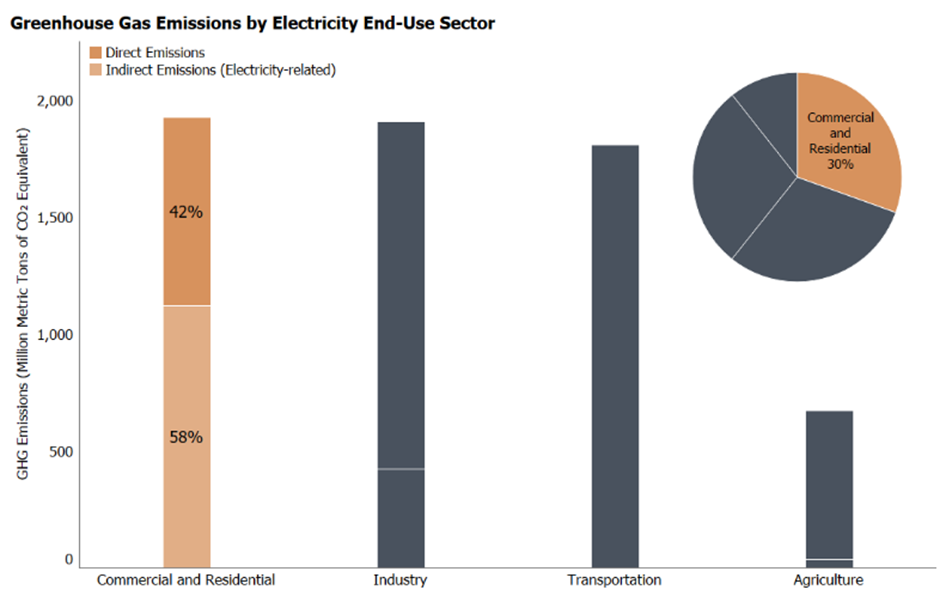By: Christina Rogelio, LEED AP BD+C
Quick Facts
- Humans spend about 86.9% of their time indoors and about 5.5% inside a vehicle, according to The National Human Activity Pattern Survey (NHAPS): A Resource for Assessing Exposure to Environmental Pollutants (2001). [1]
- Per the EPA’s Inventory of U.S. Greenhouse Gas Emissions and Sinks: 1990 – 2021, combined greenhouse gas (GHG) and electricity end-use emissions from commercial and residential buildings account for about 30% of total U.S. GHG emissions. [2]
- In 2023, the combined end-use energy consumption including electricity by residential and commercial buildings, accounted for about 27.6% of total U.S. energy consumption. [3]
Why is Building Performance Important?
Buildings are commonplace in everyday human life, serving as the nexus of where we eat, play, work, and live. Building performance impacts human health in our communities through the air we breathe. Outdoor and indoor air quality can be influenced by greenhouse gas (GHG) emissions in the built environment, which are split almost evenly between the commercial and residential sectors, as depicted below.

Examples of direct GHG emissions include fossil fuel combustion for heating and cooking needs, waste and wastewater management, and refrigerants leaks. Indirect GHG emissions include electricity use from power plants that burn fossil fuels.
General building usage also contributes to high energy costs for U.S. households and businesses. Poor indoor air quality (IAQ) can be quantified through the costs and risks associated with human health and productivity. According to the EPA, the net avoidable costs associated with IAQ pollution amount to more than $100 billion annually – about 45% of these costs are attributed to avoidable deaths caused by radon and environmental tobacco smoke, about 45% due to lost productivity, and about 10% caused by avoidable respiratory diseases. [4] Furthermore, newer high-performing buildings often install technologies that monitor air quality and ventilation systems’ performance; however, a majority of existing and older buildings do not. Finally, many people who live in communities of color and low-income communities are the most impacted by air pollution due to their proximity to air pollution sources such as factories and major roadways. [5] Human health is significantly impacted by IAQ and outdoor air pollution, which is an environmental justice issue as well.
Due to the combination of these risk factors, it is exigent for all buildings, especially residential and commercial buildings, to achieve significant emissions reductions and improved energy efficiency.
What are Some Solutions for These Issues?
It is clear that a large portion of GHG emissions drive the combined issues of air pollution, building energy and performance costs, and human health issues. It is also clear that a significant amount of GHG emissions result from residential and commercial buildings alone. To start addressing these issues, a climate policy has begun implementation not only at the federal government level, but also by local and state governments in the U.S., requiring buildings to meet Building Performance Standards (BPS) or Building Energy Performance Standards (BEPS). The purpose of implementing BPS or BEPS is to reduce energy use or emissions over time, and in effect, facilitate climate goals for and beyond commercial and residential buildings.
Stay tuned for Part 2, where we will dive deeper into BPS and BEPS, and explore how they are implemented at the national level and within Maryland!
[1] https://www.nature.com/articles/7500165
[2] https://www.epa.gov/ghgemissions/inventory-us-greenhouse-gas-emissions-and-sinks-1990-2021
[3] https://www.eia.gov/totalenergy/data/monthly/pdf/flow/total_energy_2023.pdf
[4] https://imt.org/resources/building-performance-standard-module-ventilation-and-indoor-air-quality/
[5] https://www.washingtonpost.com/climate-environment/2021/04/28/environmental-justice-pollution/
